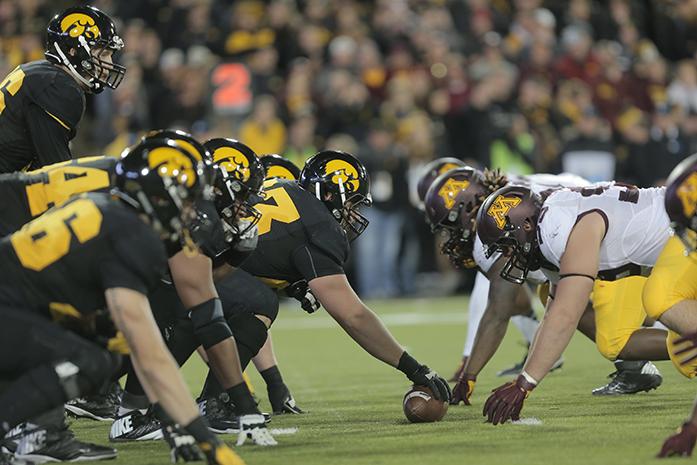Iowa’s offense hasn’t always been clicking with nearly the efficiency of last season, so what gives?
By Jordan Hansen | [email protected]
Iowa head coach Kirk Ferentz’s most effective and efficient offenses have been built around a couple smaller philosophies.
First, a strong running game to set up the play-action pass. Good offensive line play to keep defenders pushed backwards and give the quarterback time to throw. Managing the clock and winning the battle for time of possession. Good field position, few penalties, and getting ahead of the chains.
Little things that add up to big things. Bits and pieces of the game that come together to have a tremendous impact. It’s what Hawkeye players and coaches mean when they say “Iowa football.” It’s more than just a phrase to physically define the team, it’s a certain way to play the game of football.
There’s just one problem, however. The team just isn’t playing it.
“The most important things to be focused on right now are making the makeable type plays, playing clean football, and then trying to eliminate the self-inflicted wounds,” Iowa head coach Kirk Ferentz said. “They’ve been hurtful to our cause, certainly.”
Third down, especially, has been a trouble spot. It begins with how Iowa’s calling the plays and what sort of things it’s running on first and second down.
Last year, quarterback C.J. Beathard had a plethora of weapons. Tight ends George Kittle and Henry Krieger Coble were monsters on third down, combining for 11 catches and 10 first downs. Wideout Matt VandeBerg was even more dangerous on third, hauling in 22 balls for 328 yards, averaging an impressive 14.91 per catch.
Now, however, only one of those weapons remains. VandeBerg was injured before the Northwestern game, and it had a trickle-down effect. No longer does Beathard have a go-to player on third down.
This makes pumping out yardage on the first two downs is important. Setting up third and short (or moving the ball so efficiently as to avoid third and anything). It was something running back LeShun Daniels Jr. noted before the Northwestern game.
“Especially with Matt being out … we’re not going to be able to be in third-and-long situation and have the defense just pin their ears back and come after us,” Daniels said. “We’re going to have to stay on schedule.”
But staying on schedule is difficult when a team continues to find itself in third-and-long situations. In fact, of the 31 times this season Iowa been in third and 7 or longer, it has converted just 19 percent of the time (6-31).
This is a big problem. Being in these type of situations hamper drives and make it far more difficult to move down the field. Negative yardage, very short yardage, incomplete passes, and penalties all lead to these longer third downs.
Part of the problem has been protection around Beathard as well as his decision-making. Iowa’s wide receivers aren’t getting massive amounts of separation this season, and Beathard has struggled at times to get throws off.
He’s also been sacked 14 times, the second-worst mark in the league. In fact, Iowa is on pace to have allowed 7 more sacks than last year, when it also finished 13th in the stat, with 30.
It has to be frustrating for a quarterback who spent most of last year injured, and there doesn’t seem to be an end in sight. Ferentz has said several times he doesn’t want to make “reactionary” decisions on the depth chart, meaning he likely doesn’t plan on reshuffling the line.
Tackle Cole Croston has been struggling in protection, and has several holding calls and sacks given up this season. That said, Ferentz was adamant he plans on sticking with him.
“It’s not going perfect right now by any stretch, but the guys are working hard, they’ve got the right attitude. They really care, they’re invested,” Ferentz said. “Everything I’m saying, that’s Cole Croston. He’s a really tremendous young man. So he’ll work through this. He’ll fight through this.”
Whether he can fight through it, Beathard has to find some time to throw the ball. There have been a number of obvious throwing situations this year in which he simply doesn’t get a good chance to get the ball out of his hand.
He also hasn’t spent nearly as much time out of the pocket this year, something offensive coordinator Greg Davis spent a lot of time doing last season. There still are a few bootleg play-action passes, and recently Beathard has used his legs a little bit more.
“You’re never going to be 100 percent clean; I guarantee there are going to be times where I’m going to get pressure,” Beathard said. “It’s part of the game. I don’t know a game where anybody’s been able to sit back there all day and not get touched. That’s part of football.
“We do need to eliminate the sacks, and I’ll do what I can as well.”
It would help if the Hawkeyes could figure out how to get their running game back to a semblance of what it was a season ago. Iowa is averaging 38 fewer rushing yards per game, and its per-carry average has gone down as well.
Akrum Wadley and Daniels have taken the brunt of the rushing workload and have done enough to keep things moving, for the most part.
However, the “big play” ability hasn’t always been there for Iowa this season. Combined, the two backs only have five runs of 20 yards or longer.
It’s hard to put a finger on what exactly is going wrong, but run blocking has been a struggle at times for the squad as well. Rushing to the outside has been difficult at moments, frustrating both backs.
Breaking in new fullbacks has been part of the issue, and too many running plays are getting bottled up at the line of scrimmage. With VandeBerg out, it just makes things even more difficult for the offense, because the defense has one fewer star player to key on.
The players feel it’s time for a breakout game if this season is to still be salvaged.
“Our backs are against the wall right now,” Wadley said. “It all starts with the mistakes we have to correct, just getting better and sharpening our edge.”
If Iowa can manage to fix a few things, there’s certainly still reason to hope the season isn’t beyond saving. Finding a new No. 1 wide receiver would certainly help matters, as would finding a second tight end.
More options Beathard can be confident in down the field are important, and Jay Scheel, Jerminic Smith, and Riley McCarron have a tremendous amount of slack to pick up. McCarron was good in Iowa’s first game without VandeBerg, but he’s 5-9, and it won’t be hard for opposing defenses with bigger corners to shut him down.
Kittle has also been good this year but has struggled to get open. Opposing teams are devoting extra resources in order to cover him, making it far more difficult for Beathard to throw to one of his favorite receivers.
Consistent pass blocking is a must for any of this to work. If the Hawkeyes can get the offense humming even just a little bit more, it might be enough to tip the scales their way late in the season.
If not, then things very well could get uglier as the season drags on.
“I’m pretty concerned about everything right now,” Ferentz said. “And it’s really team’s meshing together. We got some guys who are doing a great job, playing really well, some other guys who maybe can improve, that type of thing. But it’s a collective effort. It really is a collective effort.”






